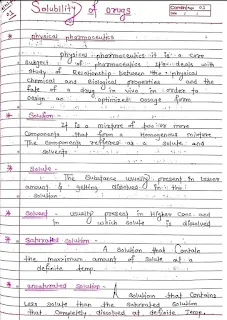Unit 1 Physical Pharmaceutics-I Notes: Solubility of Drugs
This page provides comprehensive PDF notes for Unit 1 of Physical Pharmaceutics-I, focusing entirely on the "Solubility of Drugs." These notes are essential for B.Pharm students seeking a deep understanding of pharmaceutical principles.
The material covers key topics such as solubility expressions, detailed mechanisms of solute-solvent interactions, and the concept of ideal solubility parameters. It also explores solvation and association, alongside a quantitative approach to factors influencing drug solubility. Furthermore, you'll find explanations of diffusion principles vital for biological systems, and discussions on the solubility of gases in liquids and liquids in liquids (binary and ideal solutions).
Crucially, the notes delve into Raoult’s law, real solutions, partially miscible liquids, and their critical solution temperature with applications. The Distribution law, its limitations, and applications are also thoroughly explained. This resource is designed to be a complete study guide for mastering drug solubility concepts.
Keywords: Unit 1 physical pharmaceutics notes, solubility of drugs notes, physical pharmaceutics-I PDF, solute solvent interactions, Raoult's law, distribution law, critical solution temperature, ideal solutions, binary solutions, solvation, association, diffusion principles, DuloMix, Sildes By DuloMix, free pharmacy notes.
Detailed Notes on Solubility of Drugs: Unit 1 Physical Pharmaceutics-I
The solubility of drugs is a cornerstone of pharmaceutical science, directly impacting a drug's absorption, distribution, metabolism, and excretion (ADME) profile. This detailed note for Unit 1 of Physical Pharmaceutics-I provides an in-depth exploration of this vital topic, crucial for all B.Pharm students.
Understanding Solubility Expressions and Solute-Solvent Interactions
Solubility is quantified using various expressions such as percentage (w/w, w/v), molarity, molality, and parts per million (ppm). The fundamental principle governing solubility is "like dissolves like." This concept is elucidated through an examination of mechanisms of solute-solvent interactions. Polar solvents (like water) dissolve polar solutes (ionic compounds, alcohols) through strong dipole-dipole forces and hydrogen bonding. Nonpolar solvents (like oils) dissolve nonpolar solutes through weaker London dispersion forces.
Ideal solubility parameters provide a theoretical framework to predict solubility based on the cohesive energy density of substances. A closer match in these parameters between solute and solvent generally indicates higher solubility.
Solvation, Association, and Factors Affecting Solubility
Solvation is the process where solvent molecules surround and stabilize solute molecules or ions, allowing them to disperse uniformly. In aqueous solutions, this is specifically termed hydration. Conversely, association occurs when solute molecules aggregate with each other, potentially reducing their effective concentration and solubility.
A quantitative approach to the factors influencing solubility of drugs is critical. Key factors include:
- Temperature: Generally increases solid solubility but decreases gas solubility.
- pH: Influences the ionization state of weak acids and bases, profoundly affecting their aqueous solubility.
- Particle Size: While not changing intrinsic solubility, smaller particles dissolve faster due to increased surface area.
- Polymorphism: Different crystalline forms (polymorphs) of a drug exhibit varied solubilities.
- Common Ion Effect: The presence of a common ion can suppress the solubility of sparingly soluble salts.
- Co-solvency: Using a mixture of solvents to enhance the solubility of a poorly soluble drug.
- Complexation: Forming soluble complexes with excipients can increase drug solubility.
Diffusion Principles in Biological Systems
Once dissolved, drugs must diffuse across biological membranes to reach systemic circulation and their target sites. Diffusion principles, governed by Fick's laws, describe the passive movement of molecules from an area of higher concentration to lower concentration, a crucial mechanism for drug absorption and distribution in the body.
Solubility of Gases and Liquids: Binary Solutions and Raoult's Law
The notes also cover the solubility of gases in liquids, which is dependent on partial pressure (Henry's Law) and temperature. For liquids in liquids, we differentiate between miscibility and immiscibility. Binary solutions are mixtures of two components.
Ideal solutions are theoretical constructs where intermolecular forces between all components are uniform. For such solutions, Raoult’s Law applies, stating that the partial vapor pressure of each component in an ideal mixture is equal to the vapor pressure of the pure component multiplied by its mole fraction. Real solutions deviate from Raoult's law due to differing intermolecular forces, leading to positive or negative deviations.
Partially Miscible Liquids and Critical Solution Temperature
When liquids are only partially miscible, they form two layers. The mutual solubility often changes with temperature, leading to a critical solution temperature (CST) or consolute temperature. This is the temperature at which the two liquids become completely miscible. CST has practical applications in determining purity and in extraction processes.
Distribution Law, Its Limitations, and Applications
The Distribution Law (or Partition Law) describes the equilibrium distribution of a solute between two immiscible liquid phases. The ratio of the solute's concentrations in the two phases is constant at a given temperature, known as the partition coefficient. This concept is vital for understanding drug absorption (e.g., across the gut wall), drug extraction, and distribution in the body. However, its limitations include cases where the solute associates or dissociates in one of the phases.
Understanding these aspects of solubility is fundamental for pharmaceutical professionals in designing effective drug formulations and predicting drug behavior in biological systems.
Info!
If you are the copyright owner of this document and want to report it, please visit the copyright infringement notice page to submit a report.

